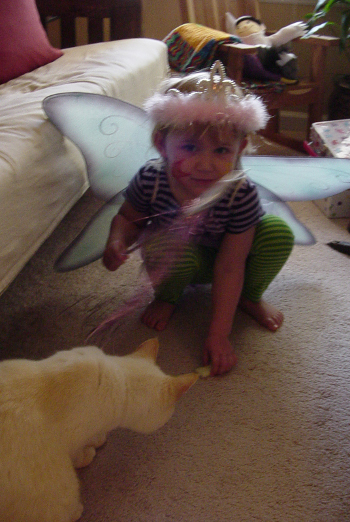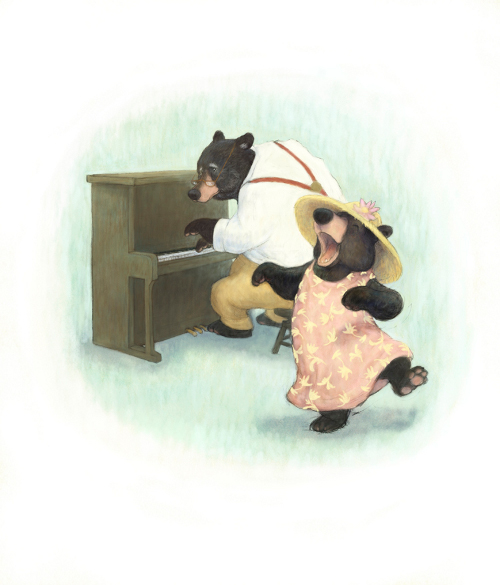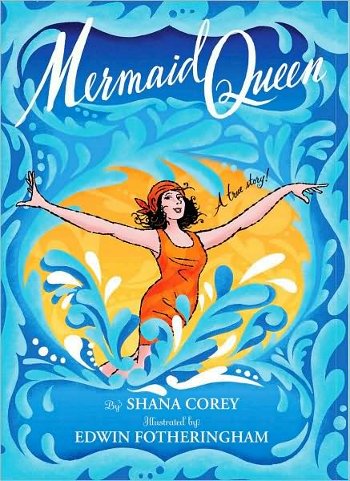7-Imp’s 7 Kicks #117: Featuring Katherine Tillotson
 Sunday, May 31st, 2009
Sunday, May 31st, 2009
Jules: See my new doll? This is my kick #1 this week and a gift from illustrator Katherine Tillotson. I received the doll—we’ll call her Mrs. Petal Pauline McWheely—just yesterday as a thank-you for today’s feature: Katherine’s here today to share some art from her newly-illustrated picture book by author Megan McDonald, It’s Picture Day Today! (to be released in June by Atheneum Books).
Mrs. Petal Pauline McWheely has a lot in common with the students in McDonald’s picture book — students with names like Buttons and Feathers. Yup, it’s a school full of art materials: Clothespins, Easter grasses, glittering stars, twisty yarns, and lots of wheely things. They all gather for the class pic, only to discover that Glue is missing. (Glue is a popular guy, as you can probably imagine.) It’s pretty much mayhem (and kudos to Katherine for keeping it interesting; I’m no artist, but it seems to me it’d be challenging to animate things like fuzzy pom-poms and string), until the picture gets snapped right before the book’s close, which opens up into a four-page spread — and which I won’t give away. But it has a lot to do with how Mrs. McWheely is structured here: Making order out of scraps, out of chaos, out of what you thought was little to nothing.
 I’m a big advocate of reading poetry to children. At home and at work — when I was in a school library, that is. One of my favorite school librarians, under whom I once interned, would open up his time with his middle-school students by simply reading a poem to them each time they visited the library. No analysis, no quizzes. Just hear and enjoy and savor. And I fervently hope my girls grow up to enjoy and read poetry on their own. Instilling an appreciation for poetry in young children is really quite simple, too — and very fun. Read it to them. Read read read poems. Play with the rhymes. Emphasize the sounds of words. Poetry celebrates the rhythms and sounds of language and word play, so if you read it a lot—outloud—and dance and snap and clap and play, they’re gonna get it. And they’ll likely enjoy it.
I’m a big advocate of reading poetry to children. At home and at work — when I was in a school library, that is. One of my favorite school librarians, under whom I once interned, would open up his time with his middle-school students by simply reading a poem to them each time they visited the library. No analysis, no quizzes. Just hear and enjoy and savor. And I fervently hope my girls grow up to enjoy and read poetry on their own. Instilling an appreciation for poetry in young children is really quite simple, too — and very fun. Read it to them. Read read read poems. Play with the rhymes. Emphasize the sounds of words. Poetry celebrates the rhythms and sounds of language and word play, so if you read it a lot—outloud—and dance and snap and clap and play, they’re gonna get it. And they’ll likely enjoy it.  I love that author/illustrator David McPhail describes himself as a misanthrope. Not only because statements like that from people who create books for children help eradicate this notion that all of them—or anyone else working near or around children, for that matter—live in little pink bubbles, surrounded by severely cute and insanely fluffy bunnies. (Seriously, the average 7-Imp reader knows they don’t, but I think that notion still prevails with the general public.) But also because of the element of surprise that resides in that statement: McPhail’s work is often infused with a sweet affection, sensitivity, and warmth and often revolves around the themes of friendship, cooperation, and familial relationships — often, but not always, animal characters, for which he is probably best-known. Not that misanthropes can’t appreciate cooperation, mind you. I guess I’m just saying: I flippin’ love it when someone surprises you.
I love that author/illustrator David McPhail describes himself as a misanthrope. Not only because statements like that from people who create books for children help eradicate this notion that all of them—or anyone else working near or around children, for that matter—live in little pink bubbles, surrounded by severely cute and insanely fluffy bunnies. (Seriously, the average 7-Imp reader knows they don’t, but I think that notion still prevails with the general public.) But also because of the element of surprise that resides in that statement: McPhail’s work is often infused with a sweet affection, sensitivity, and warmth and often revolves around the themes of friendship, cooperation, and familial relationships — often, but not always, animal characters, for which he is probably best-known. Not that misanthropes can’t appreciate cooperation, mind you. I guess I’m just saying: I flippin’ love it when someone surprises you.  Jules: Happy (upcoming) Memorial Day and happy three-day-weekend to one and all! We hope folks are around today to come kickin’ with us, and we certainly hope everyone is having a relaxing and sunny weekend thus far.
Jules: Happy (upcoming) Memorial Day and happy three-day-weekend to one and all! We hope folks are around today to come kickin’ with us, and we certainly hope everyone is having a relaxing and sunny weekend thus far.  It’s hard for me to admit this out loud, but here it is: I’m terribly vain. Not in the usual sense of the word. I mean I am preoccupied with my appearance and with others’ perception of me, but I tend to see and expect the worst of myself. And I hate it. I hate that I even care what I look like, that I actually get depressed that I don’t look like Gwyneth Paltrow or Angelina Jolie or whatever impossible standard of physical attractiveness the media are currently obsessed with. Shouldn’t it be enough that I’m decently healthy, that I have a husband and family and friends that I love, a job that I enjoy, a nice place to live, and that people keep writing great books for me to read? Do I really have to be conventionally pretty, too, to call myself happy?
It’s hard for me to admit this out loud, but here it is: I’m terribly vain. Not in the usual sense of the word. I mean I am preoccupied with my appearance and with others’ perception of me, but I tend to see and expect the worst of myself. And I hate it. I hate that I even care what I look like, that I actually get depressed that I don’t look like Gwyneth Paltrow or Angelina Jolie or whatever impossible standard of physical attractiveness the media are currently obsessed with. Shouldn’t it be enough that I’m decently healthy, that I have a husband and family and friends that I love, a job that I enjoy, a nice place to live, and that people keep writing great books for me to read? Do I really have to be conventionally pretty, too, to call myself happy?


 You guys! Do you know that there is a newly-illustrated version of
You guys! Do you know that there is a newly-illustrated version of  Here’s swimmer, film star, fashion trend-setter, and the first woman to attempt to swim the English Channel,
Here’s swimmer, film star, fashion trend-setter, and the first woman to attempt to swim the English Channel,  Corey’s
Corey’s 